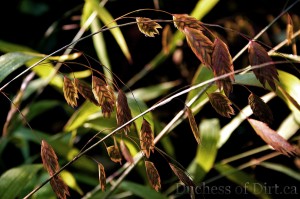Clematis viticella ‘Polish Spirit’
 Clematis viticella ‘Polish Spirit’
Clematis viticella ‘Polish Spirit’
(KLEM-uh-tis vih-tih-CHELL-ah)
Family: Ranunculaceae
Common name: Clematis ‘Polish Spirit’
Zone: 4 – 9
Height: 15 – 20 ft (4.5 – 6 m)
Spread: 3 – 5 ft (0.9 – 1.5 m)
Aspect: full sun; partial shade
Soil: humus-rich; well-draining
Water: regular
Description: A vigorous growing, deciduous vine. Masses of 3 – 4 inch (7.5 – 10 cm) velvety, violet-blue flowers are set off by rich, dark green leaves appear in mid- to late-June straight through until a killing frost.
Special Notes: This cultivar of clematis was discovered in the monastery garden in Warsaw, Poland of the well-known clematis breeder, Brother Stefan Franczak, in 1984. Plant 2 year old seedlings 12 – 18 inches (30 – 45 cm) deep in a well-prepared hole amended with compost or well-aged manure and a complete fertilizer. Pruning Group C (or Group 3); flowers on new wood. Cut vine back to 12 inches (30 cm) in late winter or early spring. Best to strap vine if grown on a trellis and exposed to high winds. Very easy care; relatively pest and disease free, including clematis wilt. Propagation by internodal cuttings in spring.
 In our Zone 7a garden: This is one of our favourite clematis. Not only is it beautiful, but it is easy care and long blooming. The previous year’s spent growth on ‘Polish Spirit’ is cut back to a height of 8 – 10 inches (20 – 25 cm) in late winter. And that’s it, pretty much. You might have to tuck the odd rogue branch back into its trellis and you do have to water the vine on a fairly regular basis.
In our Zone 7a garden: This is one of our favourite clematis. Not only is it beautiful, but it is easy care and long blooming. The previous year’s spent growth on ‘Polish Spirit’ is cut back to a height of 8 – 10 inches (20 – 25 cm) in late winter. And that’s it, pretty much. You might have to tuck the odd rogue branch back into its trellis and you do have to water the vine on a fairly regular basis.
But be prepared to wait until about mid-July before the violet-blue flowers fully burst open and start their summer show. And what a show it is! The vine will be thickly covered in flowers straight through until the first frost which is typically sometime in October in our garden.
Adjusting the soil pH with ashes or a sprinkle of lime scratched in around the vine’s base and making sure it has regular water will ensure this clematis remains pest-free.
RHS Award of Garden Merit 1993; Great Plant Pick 2002
Posted on October 12, 2012; updated on January 29, 2025
Clematis recta ‘Purpurea’
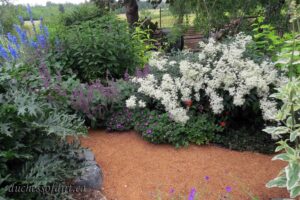 Clematis recta ‘Purpurea’
Clematis recta ‘Purpurea’
(KLEM-uh-tis RECK-tah)
Family: Ranunculaeae
Common name: purple ground clematis
Zone: 4 – 9
Height: 3 – 5 ft (1 – 1.5 m)
Spread: 4 – 5 ft (1.2 – 1.5 m)
Aspect: full sun; partial shade
Soil: humus-rich; moist; well-drained
Water: regular
Description: An herbaceous, clump-forming, non-climbing clematis with purple foliage on purple stems and panicles of small (¾-inch/1.9 cm), star-shaped, vanilla-scented white flowers from summer to fall, followed by attractive silvery seedheads.
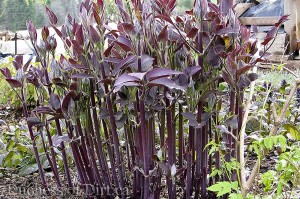 Special Notes: Native to central and southern Europe, this unique ground-sprawling clematis can be trained to climb or left to crawl along the ground. Grow in a sunny or part sun location in fertile, alkaline, well-drained soil and water regularly. Be sure to keep roots shaded and cool, as you should with all clematis.
Special Notes: Native to central and southern Europe, this unique ground-sprawling clematis can be trained to climb or left to crawl along the ground. Grow in a sunny or part sun location in fertile, alkaline, well-drained soil and water regularly. Be sure to keep roots shaded and cool, as you should with all clematis.
Treat this clematis as a Group C or 3; cut back old growth to 6 – 8 inches (15 – 20 cm) in late winter, preferably to a pair of strong buds. Young foliage is coppery purple, turning to purple with tinges of green as the season progresses. Flowers appear in early summer.
No serious insect or disease problems. Propagation by division. Can be grown from ripe seed that has had a period of vernalization.
In our Zone 7a garden: We have this plant in John’s back garden. It is mostly in shade from a large Magnolia shrub which provides some relief from the hottest of the summer days. Employing several wrought iron peony rings holds the mass of stems upright to display the ground-cover plants growing at their feet…keeping the clematis roots cool.
It garners much admiration from our garden visitors, especially when it is in full bloom.
Posted on February 28, 2024; updated on January 22, 2025
Chasmanthium latifolium
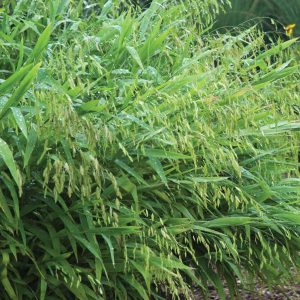 Chasmanthium latifolium
Chasmanthium latifolium
(kaz-MAN-thi-um lat-ih-FOE-lee-um)
Family: Poaceae
Common name: Northern sea oats, river oats
Zone: 3 – 8
Height: 3 – 4 ft (90 – 120 cm)
Spread: 2 – 3 ft (60 – 90 cm)
Aspect: Full sun; part shade; full shade
Soil: moist, fertile, well-drained
Water: average
Description: Clump-forming grass with light green lanceolate, bamboo-like foliage. Blades are 10 – 12 inches (25 – 30 cm) long and one-inch (2.5 cm) wide. The above ground stems (called culms) support showy, spike-like panicles above the leaves. Each panicle consists of 7 – 20 flat, green-tinged spikelets. Each individual spikelet is one-inch (2.5 cm) long, flat in appearance and scaly.
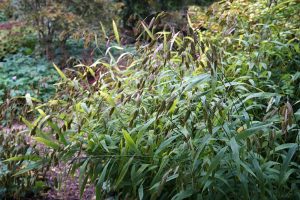 Special Notes: Native from the midwestern to eastern parts of the United States, this ornamental grass is one of the most drought and shade tolerant. While it prefers fertile soil conditions, it will thrive in all soils types and moisture conditions. Wonderful understory plant with an added benefit that it is tolerant of the toxic chemical juglone produced by black walnut (Juglan nigra) trees. Good coppery-brown fall colour in both foliage and seedheads.
Special Notes: Native from the midwestern to eastern parts of the United States, this ornamental grass is one of the most drought and shade tolerant. While it prefers fertile soil conditions, it will thrive in all soils types and moisture conditions. Wonderful understory plant with an added benefit that it is tolerant of the toxic chemical juglone produced by black walnut (Juglan nigra) trees. Good coppery-brown fall colour in both foliage and seedheads.
Plant host to some caterpillars, particularly of the Northern Pearly Eye butterfly, and skipper species. Provides cover for birds and seeds for small mammals. Good plant for containers, in mass plantings and for erosion control. Excellent in dried flower arrangements and good winter interest. Deer resistant.
Posted on November 8, 2023; Updated on January 7, 2025
Carex oshimensis ‘Evergold’
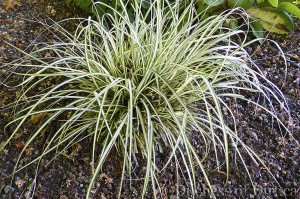 Carex oshimensis ‘Evergold’
Carex oshimensis ‘Evergold’
(KAIR-ecks oh-shih-MEN-siss)
syn. Carex morrowii ‘Aureovariegata’
Family: Cyperaceae
Common name: variegated Japanese sedge
Zone: 5 – 9
Height: 10 – 16 in (25 – 40 cm)
Spread: 10 – 16 in (25 – 45 cm)
Aspect: partial shade; full shade
Soil: medium; moist; well-draining
Water: moderate; regular
Description: A slow growing, evergreen perennial grass with a dense, clump-forming habit. Narrow leaves with creamy yellow centres edged in green form a ground-hugging, arching fountain shape. Insignificant brown flower spikes on triangular stems appear in summer.
Special Notes: Native to the rocky slopes and dry wooded areas of Honshu Island, Japan where it is commonly known as Oshima kan suge. A low maintenance, fine-textured grass which tolerates moist areas such as beside ponds but needs good drainage. Most references place this in at least partial shade but it does well in full sun with regular water. Foliage can be cut back to a low mound in late winter to rejuvenate the leaves. Spreads by rhizomes. Propagate by division in early spring or autumn. Relatively few pests and disease problems. Deer and rabbit resistant.
In our Zone 7a garden: Several clumps of ‘Evergold’ dot the landscape in my front garden as this grass species does exceptionally well in competition with the roots of my chestnut tree (Aesculus hippocastanum) and silverleaf maple (Acer saacharinum). As for deer resistance, I cannot confirm this fact as our garden is completely fenced against buffet-hunting ungulates. However, there are rabbits in the neighbourhood which can sneak in but they completely shun this grass, preferring to nibble on another grass called, Hakonechloa macra ‘All Gold’, my tulips and hosta leaf tips instead.
RHS Award of Garden Merit 1993
Posted on April 27, 2013; updated on October 30, 2024
Campanula lactiflora ‘Loddon Anna’
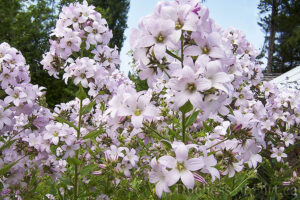 Campanula lactiflora ‘Loddon Anna’
Campanula lactiflora ‘Loddon Anna’
(kam-PAN-yew-lah lak-tih-FLOOR-ah)
Family: Campanulaceae
Common name: milky bellflower
Zone: 4 – 8
Height: 6 ft (1.8 m)
Spread: 3 ft (0.9 m)
Aspect: full sun; partial shade
Soil: fertile; well-draining
Water: moderate
Description: An herbaceous perennial with an upright habit. Medium green, oblong, toothed leaves on strong stems. Panicles of soft lavender-pink, delightfully fragrant, bell-shaped flowers appear in mid-June through July and August.
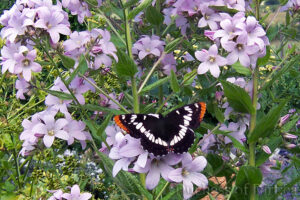 Special Notes: Native to the Caucasus region and eastern Turkey. Has commanding presence in the garden. Requires staking in its second year in exposed location. Long bloom period that attracts bees and butterflies. May produce a second flowering if cut back when first flush is ending. May suffer some slug and snail damage early in season. Propagation by seed; division in spring or autumn.
Special Notes: Native to the Caucasus region and eastern Turkey. Has commanding presence in the garden. Requires staking in its second year in exposed location. Long bloom period that attracts bees and butterflies. May produce a second flowering if cut back when first flush is ending. May suffer some slug and snail damage early in season. Propagation by seed; division in spring or autumn.
RHS Award of Garden Merit 1993; Great Plant Pick 2008
Posted on August 17, 2012; updated on October 2, 2024
